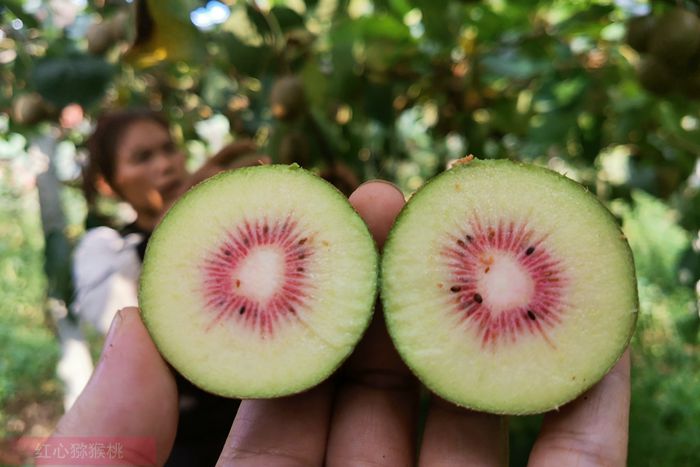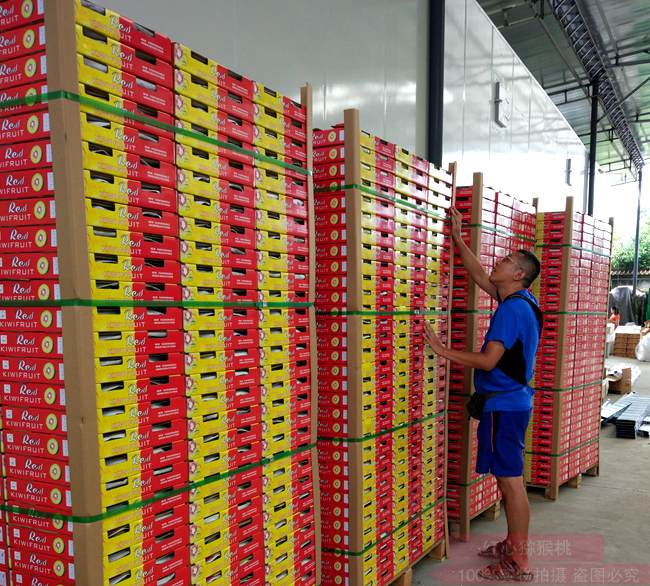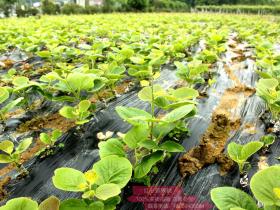How Grow and Care for Hardy Kiwi Vine
如何种植软枣猕猴桃
By DAVID BEAULIEU

▲软枣猕猴桃
Hardy kiwi vine is a cold-hardy cousin of the vine that produces the familiar kiwi fruit sold at grocery stores (Actinidia deliciosa). This cold-tolerant cultivar can be grown in USDA zones 3 through 9, depending on the variety. Like its warm-weather cousin, hardy kiwi also produces a sweet edible fruit that is smaller than a traditional kiwi (about the size of a large grape) and can be eaten whole, without peeling. Hardy kiwi is primarily featured in landscapes for its attractive heart-shaped foliage. This climber grows well on trellises, fences, pergolas, and other structures.

▲软枣猕猴桃
耐寒猕猴桃藤是一种耐寒的藤本植物的近亲,它生产在杂货店出售的人们熟悉的猕猴桃果实(美味猕猴桃)。这种耐寒品种可以在美国农业部3至9区种植,具体取决于品种。像它温暖的气候表亲一样,耐寒猕猴桃也生产一种比传统猕猴桃(大约一个大葡萄大小)小的甜可食用水果,可以完整食用,不剥皮。耐寒猕猴桃主要以其迷人的心形叶子作为景观特色。这种攀爬者在棚架、栅栏、凉棚和其他结构上生长良好。

▲Kiwi seedlings▲
Hardy kiwi should be planted in the spring after all danger of frost has passed. It will create a visual impact in its first season; however, you'll have to wait at least three years before hardy kiwi produces fruit to harvest.
耐寒的猕猴桃应该在所有霜冻危险过去后的春天种植。它将在第一季创造视觉冲击力;然而,你至少要等三年,耐寒的猕猴桃才能收获果实。

▲kiwifruit▲
Common Name Hardy kiwi, hardy kiwi vine
Botanical Name Actinidia arguta, Actinidia kolomikta
Family Actinidiaceae
Plant Type Perennial, fruit
Mature Size 10-30 ft. long
Sun Exposure Full, partial
Soil Type Loamy, well-drained
Soil pH Acidic
Bloom Time Spring
Flower Color Green, white
Hardiness Zones 3-9 (USDA)
Native Area Asia
hardy kiwi vine
The Spruce / Autumn Wood
kiwi vine growing on a trellis
Actinidia kolomikta
Hardy Kiwi Vine Care
Hardy kiwi vine is native to eastern Asia, but will grow well almost anywhere with proper care and sufficient sun. When growing this plant for foliage, shade, or fruit (or all three), train the vine on a sturdy support structure, like a trellis, arbor, pergola, or fence. It can be manipulated to form a broad canopy or to branch out horizontally in espalier form.

▲软枣猕猴桃
耐寒猕猴桃藤护理
耐寒的猕猴桃藤原产于东亚,但在适当的护理和充足的阳光下,几乎在任何地方都能生长良好。当种植这种植物以获得树叶、树荫或果实(或全部三者)时,将藤蔓种植在坚固的支撑结构上,如棚架、乔木、凉棚或围栏。它可以被操纵来形成一个宽阔的树冠,或者以espalier的形式水平延伸。

▲redkiwifruit▲
When growing kiwi vine for fruit, make sure to plant both male and female plants (you need at least one male for every eight female plants), or choose a self-pollinating variety. Keep in mind that the vine typically doesn't fruit for at least three years, and, depending on your conditions, sometimes up to five to nine years. This fast-growing, vigorous vine is rarely invasive, yet it can overcome shrubs and small trees if left unchecked.

▲软枣猕猴桃
在种植猕猴桃果实时,一定要同时种植雄性和雌性植物(每八株雌性植物中至少需要一株雄性),或者选择一种自花授粉的品种。请记住,葡萄藤通常至少三年不结果实,根据你的情况,有时长达五到九年。这种生长迅速、充满活力的藤蔓植物很少入侵,但如果不加以控制,它可以战胜灌木和小树。

▲redkiwifruit▲
Light
Hardy kiwi vine can tolerate a range of light conditions, from sun to shade, but in order to flower and produce fruit, this plant needs a full sun location. In varieties with variegated leaves, full sun also results in superior color.
光
耐寒的猕猴桃藤可以忍受一系列的光照条件,从阳光到阴凉,但为了开花和生产果实,这种植物需要一个充分的阳光位置。在有杂色叶子的品种中,充分的阳光也会使颜色更好。

▲Golden kiwifruit▲
Water
Keep the soil around your newly planted hardy kiwi continuously moist until established. Hardy kiwi relies on at least one inch of rainfall every 10 days, especially right after planting. If your climate provides this, supplemental watering is generally not needed. Weekly waterings are recommended during dry spells or in dry climates. About one gallon of water per plant, delivered through drip irrigation, should do the trick.
水
保持你新种植的耐寒猕猴桃周围的土壤持续湿润,直到成熟。耐寒的猕猴桃每10天至少需要一英寸的降雨量,尤其是在种植后。如果你的气候提供了这一点,通常不需要补充浇水。建议在干旱期或干燥气候下每周浇水。通过滴灌,每株植物大约需要一加仑的水。

▲红心猕猴桃▲
Soil
Plant kiwi vines in rich, loamy, well-drained soil. While some experts advise planting in poorer soil to control rampant growth, most vining fruit does best in garden beds amended with organic matter, such as manure or compost. Hardy kiwi does best in soil with a pH around 6.51.
土壤
在肥沃、肥沃、排水良好的土壤中种植猕猴桃藤。虽然一些专家建议在贫瘠的土壤中种植以控制猖獗的生长,但大多数葡萄在用有机物质(如肥料或堆肥)改良的园床上生长最好。耐寒猕猴桃在pH值为6.51左右的土壤中表现最好。

▲猕猴桃▲
Temperature and Humidity
Unlike its warm weather-cousin, hardy kiwi can survive winter in most areas, but it is susceptible to damage from early season frosts. For this reason, choose a planting site that is not in a frost pocket or subject to particularly cold wind in the spring. Once it reaches dormancy, however, this plant can tolerate temperatures as low as -25 degrees Fahrenheit. High-temperatures at or over 86 degrees Fahrenheit, on the other hand, can scald leaves and cause heat stress.
温度和湿度
与气候温暖的猕猴桃不同,耐寒的猕猴桃在大多数地区都能熬过冬天,但它很容易受到早期霜冻的损害。因此,选择一个不在霜冻区或春天不受特别寒风影响的种植地点。然而,一旦进入休眠期,这种植物可以忍受低至-25华氏度的温度。另一方面,86华氏度或以上的高温会烫伤树叶并引起热应激。

▲奇异果▲
Fertilizer
This vigorous vine requires little in the way of feeding. Three inches of compost provided each spring to the base of the plant provides all the nutrients necessary for the season. You can choose from a variety of appropriate products to give the fruiting plant what it needs, like aged mushroom compost, aged manure, or a rotted pine bark and aged manure mixture.
肥料
这种生命力旺盛的藤蔓几乎不需要进食。每年春天向植物底部提供的三英寸堆肥提供了该季节所需的所有营养。你可以从各种合适的产品中选择,以满足果树的需要,如老化蘑菇堆肥、老化肥料或腐烂的松树皮和老化肥料混合物。

▲redkiwifruit▲
Varieties of Hardy Kiwi
Any variety of hard kiwi vine will make your landscape efforts pop, but choosing the right one for you depends on your growth goals and your desired aesthetic. Choose a self-pollinating variety if fruit is your main focus, or select a cultivar with variegated leaves to blend with your other perennials.
耐寒猕猴桃品种
任何种类的硬猕猴桃藤都会让你的景观变得流行,但选择合适的一种取决于你的生长目标和你想要的审美。如果水果是你的主要焦点,选择一个自花授粉品种,或者选择一个叶子斑驳的品种与其他多年生植物混合。

▲Kiwi sapling▲
Pruning
It's best to prune hardy kiwi vines in winter to promote fruit production. In the first year after planting, select the most vigorous and straight shoot, designating it as the permanent trunk. Cut back the other shoots to encourage vigor in the trunk. Prune as needed during the summer to remove excessively long shoots or overgrown sections. Before the winter, cut back the stems, leaving only 8 to 10 nodes on each.
修剪
最好在冬天修剪耐寒的猕猴桃藤,以促进水果产量。在种植后的第一年,选择最健壮、最直的枝条,将其指定为永久树干。修剪其他枝条以增强树干活力。在夏天根据需要修剪,去掉过长的枝条或杂草丛生的部分。在冬天之前,把茎剪掉,每个茎上只留下8到10个节点。

▲Kiwi packaging▲
Propagating Hardy Kiwi Vine
Propagating hardy kiwi from cuttings is the preferred method used, as the cutting yields the same-sex offspring as the parent plant. Gardeners growing kiwi for fruit can easily select both male and female cuttings, should they already know the sex of the parent.
繁殖耐寒猕猴桃藤
通过扦插繁殖耐寒猕猴桃是首选方法,因为扦插产生的后代与亲本相同。种植猕猴桃果实的园丁可以很容易地选择雄性和雌性扦插,如果他们已经知道父母的性别。

▲Kiwifruit planting▲
How to Grow Hardy Kiwi Vine From Seed
Most gardeners choose not to grow kiwi vine from seed, especially if they are hoping for fruit. Growing from seed does not assure the sex of the new plant, and ending up with plants of only one sex is disappointing. That said, you can still grow the self-pollinating variety from seed if you're willing to mimic the conditions needed for stratification. To do so, extract the seeds from the fruit, rinse off the pulp, and dry them on a paper towel for two days. Next, place the seeds in a resealable plastic bag with moist seed-starting mix, and put them in the refrigerator for four months, misting the mix as needed. In the spring, plant the seeds in a seed tray filled with moist soil and place them in a sunny window until they germinate. Thin seedlings, and then continue misting the soil and growing the strongest plants until the last frost has passed. At that point, you can transplant them outside in a prepared garden bed.
如何从种子中种植耐寒的猕猴桃藤
大多数园丁选择不从种子中种植猕猴桃藤,尤其是如果他们希望结果实的话。从种子中生长并不能保证新植株的性别,而最终只有一种性别的植株令人失望。也就是说,如果你愿意模拟分层所需的条件,你仍然可以从种子中培育出自花授粉品种。为此,从水果中提取种子,冲洗果肉,并在纸巾上干燥两天。接下来,将种子放在一个可重新密封的塑料袋中,塑料袋中装有潮湿的种子起始混合物,并将其放入冰箱四个月,根据需要对混合物进行喷雾。春天,把种子种在装满潮湿土壤的种子盘中,放在阳光明媚的窗户里,直到发芽。苗木变薄,然后继续雾化土壤,种植最强壮的植物,直到最后一次霜冻过去。到那时,你可以把它们移植到室外准备好的花园床上。

▲Kiwi orchard▲
Potting and Repotting Hardy Kiwi Vine
Growing hardy kiwi vine in a container helps you dial in the perfect conditions for fruiting. This option works well for self-pollinating varieties, but if you choose to use monoecious varieties, make sure to grow a male and female next to each other and provide access to natural pollinators.
盆栽和移植耐寒猕猴桃藤
在容器中种植耐寒的猕猴桃藤可以帮助你适应完美的结果条件。这个选项对自花授粉品种很有效,但如果你选择使用雌雄同株品种,请确保雄性和雌性相邻生长,并提供自然传粉者。

▲Kiwi pollen▲
Grow your kiwi in a large container—a five-gallon bucket drilled with drain holes works well—and provide a back support or trellis behind it. Use a well-drained, slightly acidic soil that contains perlite or pumice, and amended it with organic fertilizer, such as compost or manure. Dig a hole in the soil and plant your kiwi so that the plant's roots are level with the soil line, backfill the hole to cover the roots, and relocate your plant to a sunny outdoor area. As your kiwi begins to grow, use ties to secure it to the back structure. Water it thoroughly throughout the growing season, and refresh the soil each year.
在一个大容器中种植猕猴桃——一个5加仑的桶,上面钻有排水孔,效果很好,并在后面提供背部支撑或支架。使用排水良好、含珍珠岩或浮石的微酸性土壤,并用有机肥料(如堆肥或粪肥)对其进行改良。在土壤中挖一个洞,种植猕猴桃,使植物的根部与土壤线平齐,回填洞以覆盖根部,然后将植物转移到阳光充足的室外区域。当你的猕猴桃开始生长时,用领带将其固定在背部结构上。在整个生长季节彻底浇水,每年更新土壤。

▲Kiwi pollination▲
Overwintering
Most varieties of hardy kiwi can withstand winter temperatures as low as -25 degrees Fahrenheit, still it's necessary to protect them, should you want a fruitful harvest. Young kiwi vines that are in the ground need only a little extra care. Simply wrap the trunks with frost protection or mound soil and leaves at its base.
越冬
大多数耐寒猕猴桃品种都能承受零下25华氏度的冬季温度,但如果你想要丰收的话,还是有必要保护它们。地里的年轻猕猴桃藤只需要一点额外的护理。只需在树干底部用防冻剂或土堆土和树叶包裹即可。
After a few years of overwintering, your plant should grow hardy enough to withstand cold temperatures without care. In the spring, make sure to protect new shoots from late-season frosts with a cover or blanket, as hardy kiwi sets fruit on the current season's growth. Any damage to this growth can affect your harvest.
经过几年的越冬,你的植物应该长得足够耐寒,能够毫无顾忌地承受寒冷的温度。春天,一定要用被子或毯子保护新芽免受晚季霜冻的伤害,因为耐寒的猕猴桃会在当前季节的生长中结出果实。对这种生长的任何损害都会影响你的收获。

▲Kiwi planting▲
Common Pests and Plant Diseases
Hardy kiwi vine can suffer from both pests and disease infestation. Keep an eye out for critters—like the Japanese beetle, leafroller caterpillars, root-knot nematode, and snails—which may feed on the fruit. Cover your crop during the fruiting season to keep pests away.
常见病虫害
耐寒的猕猴桃藤会遭受虫害和疾病侵扰。留意可能以果实为食的生物,如日本甲虫、卷叶毛虫、根结线虫和蜗牛。在结果季节覆盖作物以防害虫。
Infestations from bugs, like thrips and two-spotted spider mites, rarely kill the plant, but can be treated with soap and water or a neem oil spray. Avoid the use of pesticides on fruiting plants, as their use can pose harm to yourself, as well as the plant's pollinators.
虫子的侵扰,如蓟马和两个斑点的蜘蛛,很少杀死植物,但可以用肥皂和水或印楝油喷雾处理。避免在结果实的植物上使用杀虫剂,因为使用杀虫剂会对你自己以及植物的传粉者造成伤害。
Hardy kiwi can also fall victim to fungal diseases, like phytophthora crown and root rot, when neglected. Both conditions present as reddish brown roots and crowns, and can be prevented by proper soil moisture management. Botrytis fruit rot can also affect the fruit of your kiwi and cause grey mold and shriveled fruit. There is no treatment for this disease, only prevention, and fungicide use is harmful to those who eat the fruit.
耐寒的猕猴桃如果被忽视,也会成为真菌疾病的受害者,如疫霉冠腐病和根腐病。这两种情况都表现为红棕色的根和冠,可以通过适当的土壤水分管理来预防。葡萄灰霉病也会影响猕猴桃的果实,导致灰霉病和果实枯萎。这种疾病没有治疗方法,只有预防,使用杀菌剂对吃水果的人有害。

▲redkiwifruit▲
How to Get Hardy Kiwi to Bloom
If the vine does not bloom, it might not get sufficient sunlight. While the vine can be grown in partial sun, full sun is crucial for flowering and fruiting.
如何让耐寒的猕猴桃开花
如果葡萄树不开花,它可能得不到足够的阳光。虽然葡萄藤可以在部分阳光下生长,但充分的阳光对开花和结果至关重要。

▲redkiwifruit▲
Common Problems With Hardy Kiwi Vine
Other issues that affect hardy kiwi vine are linked to the plant's growth habits or damage from wildlife. The leaves and flowers can be damaged by spring frosts, and frost on flowers can mean no fruit that season. So, make sure to cover your plant's new growth should a cold front move in during the spring.
耐寒猕猴桃藤常见问题
影响耐寒猕猴桃藤的其他问题与该植物的生长习性或野生动物的破坏有关。春天的霜冻可能会损坏叶子和花朵,花朵上的霜冻可能意味着那个季节没有果实。因此,如果冷锋在春季到来,请确保覆盖植物的新生长。
Rabbits may eat the branches in the winter and deer and gophers may eat the leaves. Birds and other animals often target the fruit as it ripens. Covering the plant will help with these issues, as well.
冬天兔子可以吃树枝,鹿和地鼠可以吃树叶。鸟类和其他动物经常在果实成熟时瞄准它。报道工厂也将有助于解决这些问题。

▲redkiwifruit▲
Here are a few gardener's favorites:
Actinidia arguta 'Anananzaya' is a vigorous grower with very sweet fruit. Also called 'Anna,' this female plant is hardy down to USDA zone 5 and is one of the best fruit producers.
Actinidia kolomikta 'Arctic Beauty' creates a landscape spectacle with its white and green variegated foliage. The male plants of this cultivar typically have better leaf variegation than the female plants. This variety is hardy down to USDA zone 4.
Actinidia arguta 'Issai' is the only hardy kiwi that is self-pollinating and does not need a separate male for pollination. It is hardy down to USDA zone 5 and requires less pruning than other varieties due to its limited growth habit.
Actinidia purpurea x melanandra ‘Ken’s Red’ is a trailing, woody variety that produces a reddish-purple fruit, unlike other cultivars. It is hardy down to USDA zone 4. Once the plant matures, it can yield as many as 100 kiwis in a single season.
以下是一些园丁的最爱:
软枣猕猴桃‘Anananzaya’生长旺盛,果实非常甜。也称为“安娜”,这种雌性植物在美国农业部5区很耐寒,是最好的水果生产商之一。
猕猴桃“北极之美”以其白色和绿色杂色叶子创造了一个景观景观。该品种的雄性植株通常比雌性植株具有更好的叶片杂色。这种品种在美国农业部4区很耐寒。
软枣猕猴桃‘Issai’是唯一一种耐寒的猕猴桃,可以自花授粉,不需要单独的雄性进行授粉。由于其生长习性有限,它在美国农业部5区很耐寒,比其他品种需要更少的修剪。
猕猴桃‘肯红’是一种蔓生木本品种,与其他品种不同,果实呈红紫色。美国农业部4区的猕猴桃很耐寒。一旦这种植物成熟,一个季节可以生产多达100只猕猴桃。

▲redkiwifruit▲









